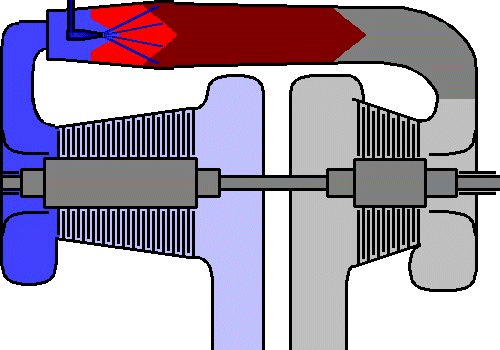|
|
Gas Turbine

Function
The gas turbine offers an escape for problems caused in the piston-stroke engine due to the repeated ignition of the aerial fuel mixture. One speaks of an engine with internal, continuous combustion.
Another crucial difference is that the intake, compression, work and exhaust take place successively in different chambers. You may very well draw a parallel to the jet engine. Advantages are the easier controllable exhaust gas emissions and the lower weight to power ratio; disadvantageously are
the high revs, causing less favourable control possibilities, the bad efficiency and the loud, unpleasant noises.
The gas turbine is hot again because manufacturers are searching for improved exhaust gas emissions and alternative fuels. With regard to these topics the gas turbine is nearly unbeatable because it gets by with
nearly every fuel and has a relatively high aerial percentage, like the diesel engine. The high mileage of course also
causes a lot of CO2, however, developing improved regenerators might limit the CO2 percentage in the exhaust gases. And hopefully also the unfavourable controlling. In combination with
other engines, maybe the hybrid, the gas turbine in the vehicle area could gain its place.
How it works
Depending on the power, filtered air is permanently (see picture: middle below to the left) sucked in. The air runs through a radial compressor (to the left) and reaches - compressed to several bar - the combustion
chamber into which continuously fuel is injected. The octane rating of the fuel is as unimportant as the fact whether it is gaseous or liquid. The last part of the whole cyclic process is important, when the expanded
exhaust air leaves the case through the blades of the power turbine (to the right). It is pushed to revs of several 10,000 1/min which must of course be reduced for the usage in the automobile with the help of a speed
reducer transmission and gear box or final drive to wheel speed.
It is easy to imagine that all resigning thermal energy means a loss for the whole process. Therefore, there is a range of devices to deliver this heat before entry into the power turbine to the fresh gas. One of them is a
rotary regenerator positioned in between entry and outlet from the combustion chamber. It is a big, round heat exchanger on a vertical shaft which is driven by the turbine via a bevel wheel drive.
Another problem presents the low rev of the compressor turbine during the initial drive. Therefore, there are several interlocking shafts, instead of one single shaft for the compressor turbine and the power turbine.
This way both turbine shafts can be separated from each other. Thus, the compressor can rotate in certain working conditions faster than the power turbine. Additionally, the sucked air can be accelerated in the
compressor by faster rotating blades and deliver its energy to the more slowly rotating power turbine. One speaks of a 'two '-and '3 shafts' gas turbine. In addition, adjustable guide blades are conceivable. 06/08
|
|